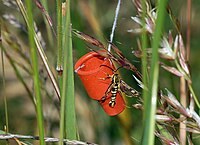
Photo from wikipedia
Simple Summary The peachtree borer and lesser peachtree borer are destructive insect pests of peach and other stone fruit. Damage is caused by larval feeding on the vascular cambium, which… Click to show full abstract
Simple Summary The peachtree borer and lesser peachtree borer are destructive insect pests of peach and other stone fruit. Damage is caused by larval feeding on the vascular cambium, which reduces tree health and vigor and can lead to tree death. The traditional method to control these pests is with directed trunk sprays of the organophosphate insecticide, chlorpyrifos. However, the ongoing review of pesticide tolerances mandated by the United States Environmental Protection Agency (US-EPA) makes the option of future long-term use of chlorpyrifos uncertain. Mating disruption is an alternative method of control that uses synthetic sex pheromones to disrupt male mate-finding behavior and prevent mating. We conducted field studies to compare the efficacy of mating disruption and application of chlorpyrifos insecticide for control of this pest complex. Although our data indicated that mating disruption can provide growers with an effective non-chemical alternative to chlorpyrifos trunk sprays, several variables may affect its long-term success in West Virginia peach orchards; most notably the presence of high population densities of the pest species, problems with maintaining adequate pheromone coverage in orchards, and the need for area-wide implementation. Abstract The peachtree borer, Synanthedon exitiosa, and lesser peachtree borer, S. pictipes, are economically important indirect pests of peach in West Virginia. The purpose of this 3-year study was to compare the efficacy of mating disruption and post-harvest trunk sprays of chlorpyrifos insecticide for control of this pest complex in a commercial peach orchard. Overall, Isomate PTB-Dual disruption dispensers applied at a rate of 371/ha significantly disrupted the male mate-finding behavior of S. exitiosa and S. pictipes. In addition, the infestation of peach trees by S. exitiosa larvae did not vary significantly between mating disruption and insecticide treated plots. Hot-spot maps of S. exitiosa infestation showed significant spatial clusters of infestation predominately near the perimeter of all orchard plots, or where trees were missing within and/or between rows. The generation of standard deviational ellipses revelated that the location of S. exitiosa infestations in orchard plots remained relatively constant between years, and were generally oriented in a north and easterly direction, which coincided with the prevailing wind direction. Although our data indicated that mating disruption can provide growers with an effective non-chemical alternative to chlorpyrifos trunk sprays, several variables may affect its long-term success in West Virginia peach orchards; most notably the presence of high population densities, problems with maintaining adequate pheromone coverage, and the need for area-wide implementation.
Journal Title: Insects
Year Published: 2020
Link to full text (if available)
Share on Social Media: Sign Up to like & get
recommendations!